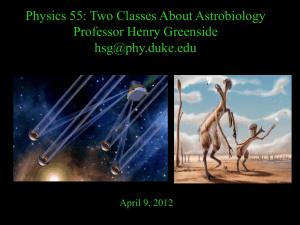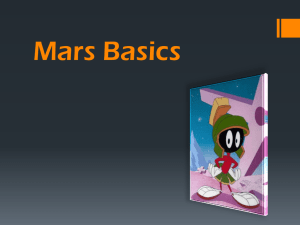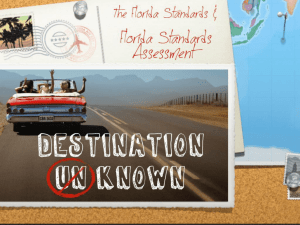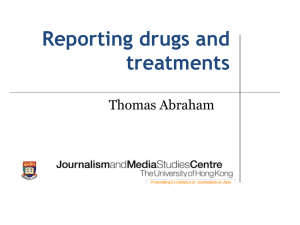Construct viable arguments and critique the reasoning of others
advertisement
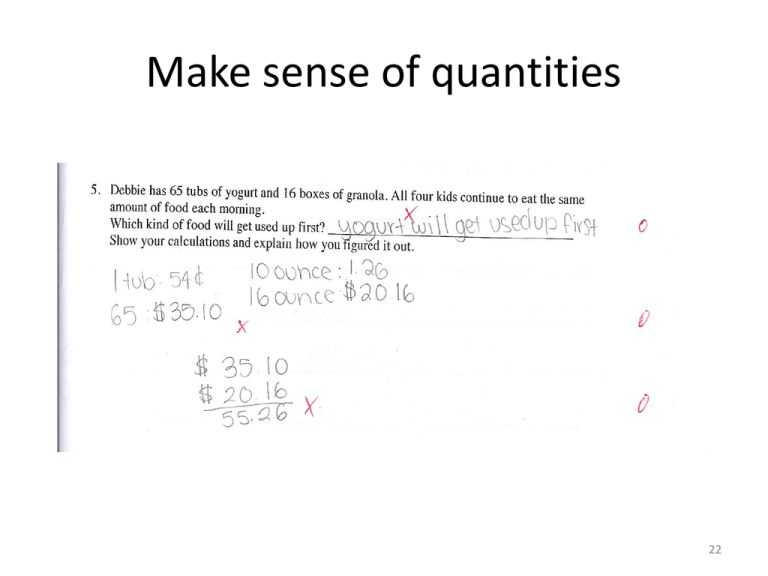
Make sense of quantities 22 How do quantities fit into the problem 23 Abstract and Recontextualize 24 Mathematical Practice: Construct viable arguments and critique the reasoning of others. Build logical progression of statements to explore conjectures Recognize and use counterexamples Justify their conclusions and respond to other’s ideas using drawings, diagrams, actions 25 5th Walls With Windows 26 Draw a picture 27 Use a table 28 Build on previous knowledge or calculations 29 Mathematical Practice: Model with mathematics. Solve problems in everyday life Write equation to describe a situation Solve a design problem Make assumptions and approximations to simplify a complicated situation Interpret results to see if they make sense in terms of the situation 30 Singing at the Ballpark- 4th 21 students need to get to the ballpark. Each car will carry one adult and up to 4 students. 5 ¼ cars please? 31 Interpret results into context to check for reasonableness 32 Check for Reasonableness 33 Check for Reasonableness You can’t leave someone behind!!!! 34 Solve a design problem – 5th 35 Real Life Situation 36 Write an equation to model 37 Map relationships between Quantities 38 Mathematical Practice: Use appropriate tools strategically. Use paper pencil, concrete models, ruler, protractor, calculator, spreadsheet, etc. Tools might also include choosing an appropriate mathematical strategy 39 Strategy - Slope 40 Tools - Calculator 41 Tools Calculator – Strategy Convert to decimals 42 Mathematical Practice: Attend to precision. Communicate precisely with clear definitions State meaning of symbols Calculate accurately, efficiently, and use appropriate level of precision 43 Have a Clear Definition • Teacher comments on 2-4 tests: Why do the tasks use the word angle when our textbooks use “vertex”? 44 Words are tools for thinking Not having words to use limits the mathematics we can think about. – Harold Asturias, Lawrence Hall of Science Teacher comments: Why did you use the word “dimensions” on the 5th grade task box of cubes? Why didn’t you just ask for length, width, and height? 45 Cognitive Demand • How many dimensions are there? 46 Dimensions? 47 Dimensions? 48 Diagonal 49 Mathematical Practice: Look for and make use of structure. Discern pattern or structure See complicated things, such as algebraic expressions as single objects or as composed of several objects 50 5th- Box of Cubes- Structure 51 Making Sense of Structure Seven most important words to transform education: How did you Figure that out? 52 7th Grade Freezing in Fargo • How many times colder is Wednesday Feb. 25th than Tuesday Feb. 3rd? Almost 40% of the students in the sample subtracted. 53 Mathematical Practice: Look for and express regularity in repeated reasoning. Look for repeated calculations in both general methods and for short cuts 54 6th Freezing In Fargo • Which week (Sunday through Saturday) recorded the average lowest temperature? A student noticing that all the averages are divide by 7 days should realize that comparing totals will yield some comparative results without needing to divide. 55 Tools For Practices and Standards • Use MARS Tasks – Define the meaning of the standards and practices – Raise expectations for teachers about what students are capable of accomplishing – Help teachers anticipate misconceptions so that they can be surfaced and addressed in class discussion and re-engagement lessons 56 Resources • SVMIMAC.org website • Inside Mathematics.org directly or through link in NCSM 57 TOOLS BY SUBJECTAlgebra & FunctionsAlgebraic Properties & RepresentationsData AnalysisFunctions & RelationsGeometry & MeasurementMathematical Reasoning & ProofsNumber OperationsNumber PropertiesPatterns, Functions & AlgebraProbabilityStatistics 3rd GradeCore IdeasRecognize and use characteristics, properties, and relationships of two-dimensional geometric shapes and apply appropriate techniques to determine measurements.Choose appropriate units and tools for particular tasks and use these units and tools to estimate and measure (length, weight, temperature, time, and capacity).Identify and compare attributes of two-dimensional shapes and develop vocabulary to describe the attributes.Calculate perimeter and area and be able to distinguish between the two measures. (Area may be measured by covering a figure with squares.)Use visualization, spatial reasoning, and geometric modeling to solve problems.Recognize geometric ideas and relationships and apply them to problems.MARS TasksLooking Glass LandTaskRubricCore Mathematical Ideas and ChallengesQuestions for Teacher ReflectionDiscussion of Successful Examples of Student WorkDiscussion of Student MisconceptionsGraph and Analysis of the MARS Task DataSummary of Student Understandings and MisunderstandingsImplications for Instruction 58 59 60 Practices Require Content • Looking at and Understanding Number System • Using Place Value Strategies to Make Sense of and Solve Problems • Understanding Number Line as a basic mathematical concept and tool Butterfly and Moth Collection How much longer was the longest wingspan than the shortest? Research Suggests: • Number lines help students understand fractions as a “single number” instead of two – unique point or location on the line • Number line concepts and reading fractions can be introduced through rulers, clocks, scales • Number lines help students develop the ability to generalize about number and operations Knowing Fractions Knowing Fractions MARS 2012 Grade 4 Task 1 Butterfly and Moth Collection 25% 20% 15% 10% 5% 0% Series1 0 6% 1 10% 2 13% 3 18% 4 19% 5 8% 6 5% 7 21% MARS 2012 Grade 5 Task 3 Knowing Fractions 18% 16% 14% 12% 10% 8% 6% 4% 2% 0% Series1 0 2% 1 10% 2 15% 3 16% 4 13% 5 9% 6 9% 7 11% 8 5% 9 10% MARS 2012 Grade 6 Task 3 Fraction Match 30% 25% 20% 15% 10% 5% 0% Series1 0 26% 1 14% 2 16% 3 13% 4 10% 5 10% 6 7% 7 5% Preparing for Geometry • To do the type of work needed to be successful in geometry, students need to have a variety of experiences at earlier grades. • Ideas build over time. Purpose of Resources MARS 2012 Grade 4 Task 2 Looking for Shapes 25% 20% 15% 10% 5% 0% Series1 0 8% 1 14% 2 22% 3 15% 4 14% 5 14% 6 14% MARS 2012 Grade 5 Task 2 A Box of Cubes 45% 40% 35% 30% 25% 20% 15% 10% 5% 0% Series1 0 14% 1 4% 2 10% 3 4% 4 6% 5 14% 6 9% 7 38% MARS 2012 Grade 6 Task 5 Unfolding a Box 40% 35% 30% 25% 20% 15% 10% 5% 0% Series1 0 36% 1 24% 2 12% 3 4% 4 5% 5 4% 6 5% 7 4% 8 4% 9 3% MARS 2012 Grade 7 Task 1 Similar Figures 25% 20% 15% 10% 5% 0% Series1 0 22% 1 16% 2 8% 3 17% 4 9% 5 14% 6 10% 7 1% 8 2% MARS 2012 Course 2 Task 4 The Company Logo 35% 30% 25% 20% 15% 10% 5% 0% Series1 0 0% 1 5% 2 26% 3 19% 4 32% 5 4% 6 1% 7 1% 8 4% 9 3% 10 4% MARS 2012 Course 2 Task 5 Trapezoid Blocks 45% 40% 35% 30% 25% 20% 15% 10% 5% 0% Series1 0 8% 1 7% 2 8% 3 11% 4 41% 5 3% 6 8% 7 4% 8 5% 9 1% Developing Algebraic Thinking Describe T pattern 5. MARS 2012 Grade 2 Task 5 Misha's Marbles 30% 25% 20% 15% 10% 5% 0% Series1 0 3% 1 10% 2 3% 3 11% 4 8% 5 25% 6 17% 7 23% Lattice Fence – 6th Define the pattern to explore relationships. MARS 2012 Grade 6 Task 4 Lattice Fence 25% 20% 15% 10% 5% 0% Series1 0 7% 1 21% 2 14% 3 13% 4 17% 5 10% 6 5% 7 9% 8 1% 9 2% Aussie Fir Tree - Algebra MARS 2012 Course 1 Task 5 Aussie Fir Tree 16% 14% 12% 10% 8% 6% 4% 2% 0% Series1 0 7% 1 12% 2 8% 3 8% 4 7% 5 9% 6 10% 7 15% 8 8% 9 9% 10 7% Proportional Reasoning MARS 2012 Grade 7 Task 1 Similar Figures 25% 20% 15% 10% 5% 0% Series1 0 22% 1 16% 2 8% 3 17% 4 9% 5 14% 6 10% 7 1% 8 2% Rate Concentrate – 6th MARS 2012 Grade 6 Task 1 Rate Concentrate 25% 20% 15% 10% 5% 0% Series1 0 23% 1 15% 2 3% 3 24% 4 15% 5 4% 6 17% Using the 8th Grade Test 8th Grade - Tool • Understand the 8th grade Mathematics Common Core Course and the deep rich mathematical expectations for students • Includes rich Algebra Strand but also works to expand and deepen understanding and facility with other strands • Use as Placement Test or Summative Test - Could your 7th graders pass this test? Could your Algebra and Geometry students meet standard on test? • Facilitate Course Discussion with Staff and Parents – Is this the mathematics we want students to be able to know and do? Implementing Formative Assessment Lessons- Forming Professional Learning Communities – How do we create classroom culture? – How do we facilitate “staff” doing mathematics together to understand purpose of the lesson, understand the mathematics before giving it to students, work as a learning community to discuss techniques, purpose of using student work, types of comments to put on student papers, how to have a plenary discussion? What are the important mathematical ideas to be drawn from students? What teacher moves help hold all students accountable for their own learning? – Making time for lessons?







